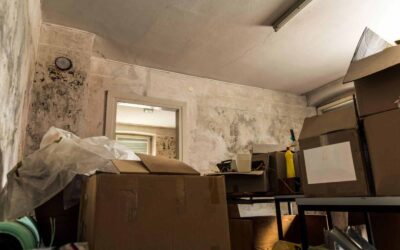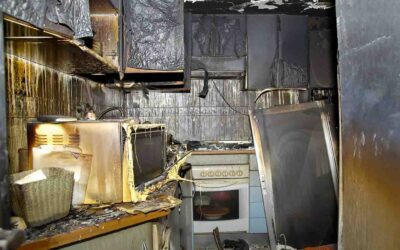Exposure to mold is harmful, especially when it has made itself at home in your residence. Your house should be a safe place to rest, work, and live without fear of exposure to harmful toxins. When mold moves in, however, it puts everyone’s health at risk.
Mold in a home can be particularly harmful because of the daily exposure to these harmful spores for long periods of time. Living with mold on a regular basis can lead to an array of health complications. Is mold in the house really that serious? In short, yes.
Fortunately, timely detection and removal is your ally. A prompt response and thorough removal are your strongest offense against mold health risks.
What Is Mold and Why Is It Harmful?
Mold is a type of fungi and a natural part of the environment. It can form easily where moisture and oxygen are present. To reproduce, mold produces tiny spores that continually move through the air. Once mold spores make contact with a damp, organic surface, they begin to grow. Outdoors, mold assists in the breakdown of plant and animal matter and is vital to the ecosystem. Indoors, however, mold growth becomes a problem.
Mold in the home is prevalent in areas with high moisture, such as bathrooms, laundry rooms, kitchen cabinets, vents, basements, and crawlspaces. While some molds are benign, others can produce allergens, irritants, and mycotoxins (toxic chemicals produced by certain fungi). Mycotoxins can cause a range of health problems, some with long-term effects.
What Are the Top Mold Health Risks?
The top health risks associated with mold in homes can range from allergic reactions to respiratory problems and, in more severe cases, infections. Even in the mildest cases, mold can compromise your quality of life with constant allergic reactions, resulting in sneezing, coughing, itchy or burning eyes, stuffy nose, and congestion. This is especially true for people with pre-existing allergies.
More severe cases can lead to respiratory irritation and infections, causing serious illness that may have potential long-term effects. More vulnerable populations are at particular risk. These populations include immune-compromised people and anyone with pre-existing allergies or respiratory conditions, as well as infants and children, elderly, or pregnant people.
Let’s explore the top mold health risks you or your loved ones could be vulnerable to:
Allergic Reactions
The most common symptoms from allergic reactions due to mold are watery, itchy, or burning eyes; congestion; a stuffy or runny nose; coughing; sneezing; wheezing; and skin rashes.
Respiratory Issues
Mold can lead to a variety of respiratory problems. These can include respiratory infections, rhinosinusitis and bronchitis, hypersensitivity pneumonitis, and asthma.
What are signs that you may be suffering from respiratory symptoms due to mold? Watch for:
- Headaches
- Fatigue
- Difficulty breathing
- Wheezing
- Coughing
- Throat irritations such as a sore throat
- Skin irritations such as rashes
- Eye irritations such as red, itchy, and watery eyes
- Nasal and sinus congestion
Asthma
Asthma can develop from regular exposure to indoor mold. This long-term respiratory issue may cause difficulty breathing, leading to shortness of breath, wheezing, and chest tightness. When mold is inhaled, it can constrict airways and trigger asthma episodes.
Fortunately, symptoms can improve with proper mold removal and cleaning.
Neurological Disorders
Mold spores can produce mycotoxins that disrupt synapse function and cause neurological symptoms. Symptoms can manifest as cognitive impairment, mood disturbances, and impairments to the peripheral nervous system.
Common symptoms of these neurological disorders may include:
- Brain fog
- Confusion
- Disorientation
- Difficulties with memory
- Impaired hand-eye coordination
- Depression
- Anxiety
- OCD-like behavior
- Dizziness
- Vertigo
- Numbness and tingling
- Sensitivity to light
- Ringing in the ears
Immunological Disorders
Mold can potentially trigger autoimmune responses and cause or exacerbate autoimmune diseases such as Hashimoto’s disease, multiple sclerosis, and vitiligo. It can also produce other immunological disorders such as:
- Chronic sinusitis
- Allergic rhinitis
- Conjunctivitis
- Dampness and mold hypersensitivity syndrome (DMHS)
These can lead to inflammation, pain, and cognitive symptoms.
Chronic Inflammatory Response Syndrome
Chronic inflammatory response syndrome (CIRS) is a biotoxin-triggered immune dysfunction disorder most commonly occurring from exposure to microbial growth, including mold. Left untreated, it can be debilitating.
Symptoms of CIRS commonly include:
- Brain fog
- Loss of executive function
- Memory loss
- Mood disorders
- Chronic fatigue
Lung Infections
Some invasive molds can enter your lungs and cause lung infections. Most health issues caused by mold are caused by the fungus Aspergillus fumigatus. Aspergillosis is a lung infection that can lead to difficulty breathing, fever, and coughing up blood. These symptoms can range from mild to severe.
Non-aspergillus mold infections include mucormycosis and paracoccidioidomycosis. The former can cause nose bleeds and numbness in the face, while the latter is a dimorphic fungus generally acquired through the lungs.
Early Detection and Removal Is Key
To prevent any of the above health conditions and accompanying symptoms, timely detection and removal of mold is of utmost importance. Look for signs of mold in your home, and be vigilant if you are experiencing any of these symptoms.
How do you know if you have a mold problem? You can often see or smell mold. Check for musty odors and mold growth in high moisture areas such as bathrooms, refrigerator seals, window molding, and surfaces surrounding air conditioners.
If you notice any of the telltale signs, call in mold remediation professionals immediately. A simple DIY cleaning hack may not be enough to thoroughly remove mold and prevent serious health risks.
Remember, not all mold remediation is created equally. With Biodynamic, get the results your family deserves. We are the only company in the Pacific Northwest with a commitment to a non-toxic process. How else are we different? We do not perform our own testing, and 97 percent of our projects pass third-party exit testing on the first attempt. We pride ourselves on results you can count on, with communication and services that put you first.
What can you expect from our quality services? A three-phase plan with guaranteed results:
- Set up (meet and set up environmental controls and equipment)
- Remediate (clean/remediate all non-porous materials, remove affected porous materials, clean treatment area)
- Clean (HEPA vacuum the entire treatment area, apply anti-microbial and mold prevention shield, meet the testing company for final exit testing)
It’s as easy as 1-2-3!
Contact Biodynamic for mold removal and make your home a healthy and safe place to live.


